Physical Address
304 North Cardinal St.
Dorchester Center, MA 02124
Physical Address
304 North Cardinal St.
Dorchester Center, MA 02124
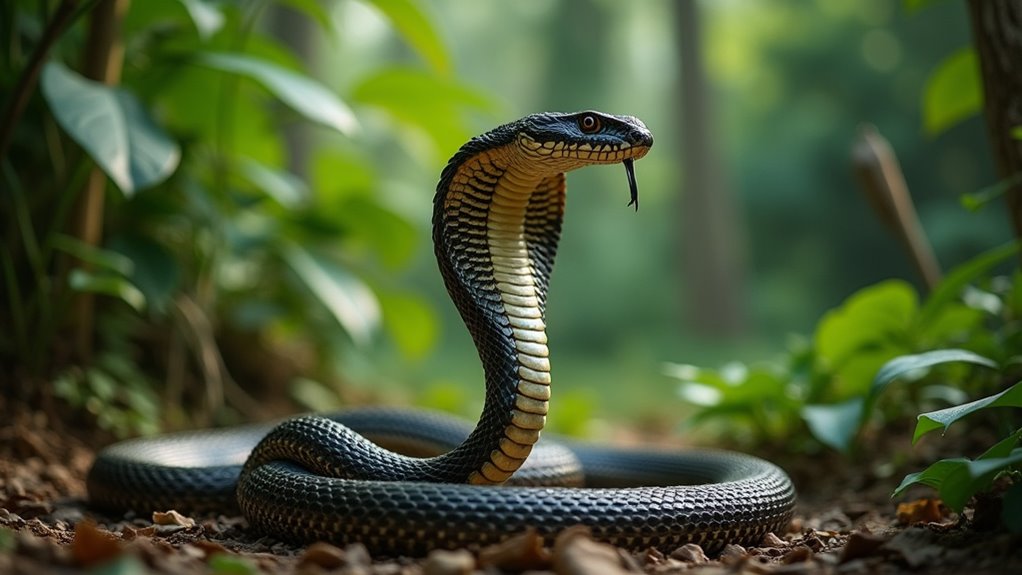
Hidden beneath Thailand's paradise lurks deadly wildlife, from venomous cobras to aggressive elephants – which creature poses the greatest threat?
Thailand’s wildlife presents real dangers to visitors and locals alike. You’ll need to watch for venomous serpents like the King Cobra, Malayan Krait, and Monocled Cobra in both rural and urban areas. Box jellyfish and stonefish lurk in coastal waters, while Asian elephants can become deadly when threatened. Other hazards include bull sharks, giant centipedes, and Malayan pit vipers. Understanding these creatures’ habitats and behaviors will considerably improve your safety during your Thai adventures.
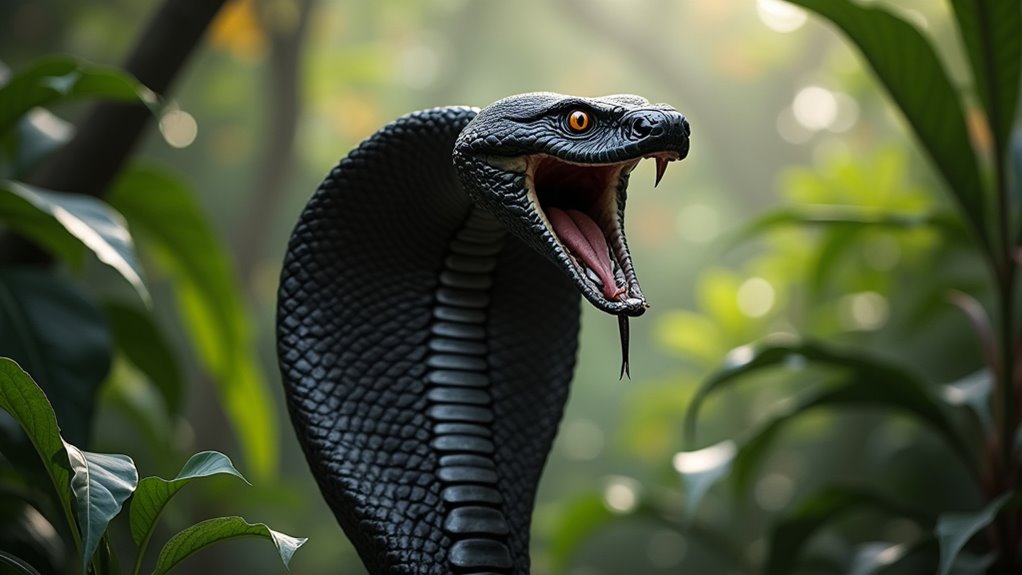
When wandering through Thailand’s diverse landscapes, you might encounter the majestic king cobra, the world’s longest venomous snake. These impressive reptiles stretch 3-4 meters on average and inhabit forests, grasslands, and even agricultural areas across the country, especially near water sources.
Thailand’s dense forests and lush farmlands house the king cobra — a majestic yet deadly serpent reaching impressive lengths.
If you stumble upon one, you’ll recognize its distinctive expandable hood and olive-green to black coloration with pale yellow crossbands.
When threatened, it raises up to one-third of its body length, emits a deep hiss, and can strike from an impressive distance of 2 meters. The species is known to construct above-ground nests to protect its eggs, with females guarding them vigilantly during the incubation period.
With venom potent enough to kill an adult human (delivering 400-500mg per bite), encountering a king cobra demands immediate medical attention—treatment within an hour significantly improves survival chances. While exploring the Land of Smiles, remember that most snakes will avoid humans unless they feel threatened or cornered.
While the king cobra commands attention with its imposing size and dramatic displays, Thailand harbors another venomous serpent that’s equally lethal but far more secretive. The Malayan Krait, also known as the Blue Krait, is a nocturnal predator common throughout Thailand, especially in the northeast’s flatlands. This deadly snake can reach up to 108 cm in length, making it a substantial threat when encountered.
The Malayan Krait is considered one of the most venomous snake species in Thailand, earning its reputation as a silent but deadly predator.

Among Thailand’s most dangerous wildlife inhabitants, the box jellyfish lurks nearly invisible in coastal waters, particularly in the Gulf of Thailand. These square-bodied creatures are considered the world’s most venomous marine animals, with tentacles stretching up to 3 meters.
Unlike typical jellyfish, they’re active swimmers with rudimentary eyes that help them navigate. Their sting can cause paralysis, cardiac arrest, and death within minutes.
In the past two decades, five confirmed deaths have occurred, with most victims being foreign travelers.
You’ll face higher risks in the Gulf of Thailand than along the Andaman Coast, where incidents are rarer. If you’re planning to explore Naka Cave, consider including time for coastal excursions in safer regions with proper precautions. Their transparent bodies make them particularly dangerous—you won’t see them coming until it’s too late.
When swimming in Thai coastal waters, always heed local warnings about jellyfish sightings. Immediate application of vinegar is recommended as the best first-aid treatment for box jellyfish stings.
From the waters of Thailand to its urban landscapes, dangers lurk in unexpected places. The monocled cobra has adapted remarkably well to human environments, making it Thailand’s most encountered venomous snake. You’ll find these deadly serpents in cities, villages, rice paddies, and agricultural areas up to 1,000 meters elevation. These cobras are identified by their distinctive O-shaped hood pattern, unlike the spectacle pattern seen in Indian cobras.
Thailand’s silent predator slithers between urban streets and rural fields, adapting effortlessly to human presence while carrying deadly potential.
Unlike the many stray dogs that roam Thai streets and are generally harmless to humans, monocled cobras pose a serious threat when encountered.
When exploring Thailand, remain vigilant in both wilderness and urban settings where these adaptable predators thrive.
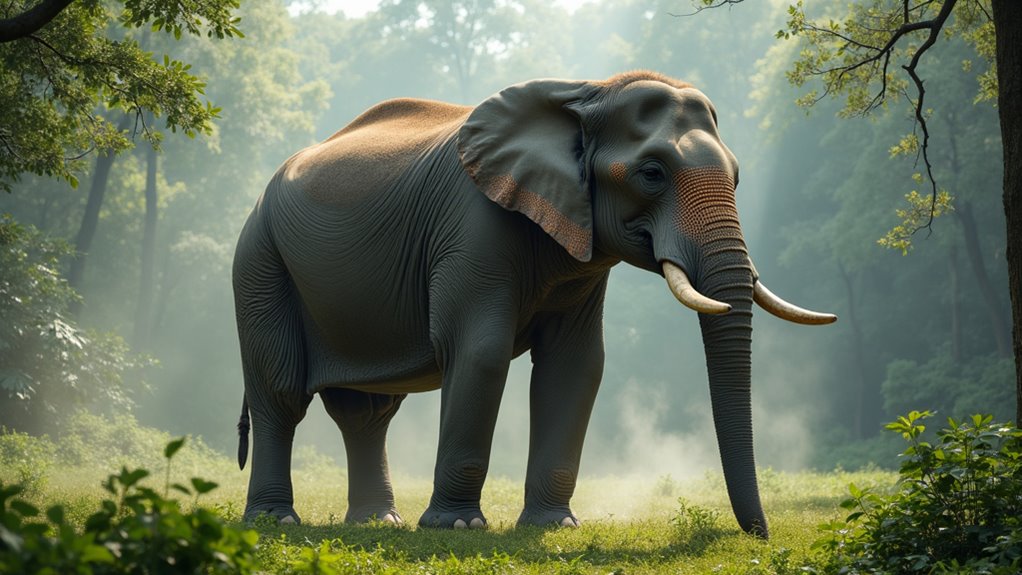
Thailand’s endangered Asian elephants exemplify nature’s paradox: majestic creatures that inspire awe while posing serious danger to human populations. These five-ton behemoths have caused over 130 human deaths since 2018, primarily in western Thailand’s farming communities.
As habitat loss drives them from forests into agricultural areas, you’ll find these typically gentle herbivores becoming increasingly aggressive. They’ll travel extensive distances (males roam up to 407 km²) in search of food, consuming 150-200 kg of vegetation daily and frequently raiding farms for cassava and sugarcane. They’re particularly attracted to cultivated crops like bananas and rice, which often leads to destructive encounters with local farmers.
Despite conservation efforts increasing their numbers by 7-10% annually in protected areas, human-elephant conflicts continue to escalate. Some protected areas like Koh Chang offer safer opportunities to observe these magnificent animals in their natural habitat. If you’re exploring Thailand’s rural regions at dawn or dusk, remain vigilant—these intelligent creatures use infrasonic communication to coordinate movements, making encounters unpredictable and potentially fatal.
While the Asian elephants may inspire awe with their size, it’s the tiny mosquitoes that pose the deadliest threat to your health when traveling through Thailand. These insects serve as vectors for numerous serious diseases including dengue, malaria, and Japanese encephalitis.
Rainy seasons bring dramatic increases in mosquito populations and associated disease risks. Researchers have documented mosquitoes in 1,725 locations across 66 Thai provinces, highlighting their widespread presence throughout the country.
Urban areas face different threats than rural zones – dengue dominates cities while malaria persists in forest regions. Travelers planning to divide their time between Bangkok or Chiang Mai should be aware of the specific mosquito-borne disease risks in each location.

Traveling through Thailand’s bustling streets and serene beaches, you’ll inevitably encounter some of the country’s 8.5 million dogs, including roughly 2 million strays. These ownerless canines are particularly concentrated in urban areas, with Bangkok hosting about 42 per square kilometer.
While most aren’t aggressive, they pose a serious rabies risk. Dogs account for over 98% of human rabies transmissions globally, and the disease remains endemic in Thailand. Recent vaccination campaigns have targeted hundreds of animals monthly to reduce this threat.
Though often docile, Thailand’s stray dogs remain a primary vector for rabies, an endemic disease demanding visitor vigilance.
To stay safe, never approach unfamiliar dogs, especially in cities. If bitten, seek immediate medical attention for post-exposure prophylaxis. Consider pre-travel rabies vaccination if you’re planning extended stays.
Local sterilization programs aim to reach the critical 80% threshold needed for population control, but until then, maintain cautious awareness around Thailand’s street dogs.
Among the most formidable predators you might encounter in Thailand’s coastal waters, bull sharks command serious respect for their unique adaptability and aggressive nature. These powerful hunters frequent the Chao Phraya River mouth and can travel far upstream, thriving in both salt and freshwater environments. With their impressive bite force, bull sharks can easily capture challenging prey including fish, rays, and even other sharks. While exploring Thailand’s diverse wildlife habitats, travelers should be aware that these sharks are just one of the unique animals that inhabit the country’s waters.
If you spot a bull shark, remain calm and retreat slowly without sudden movements.
Always heed local warnings and avoid swimming in river mouths or murky estuaries.
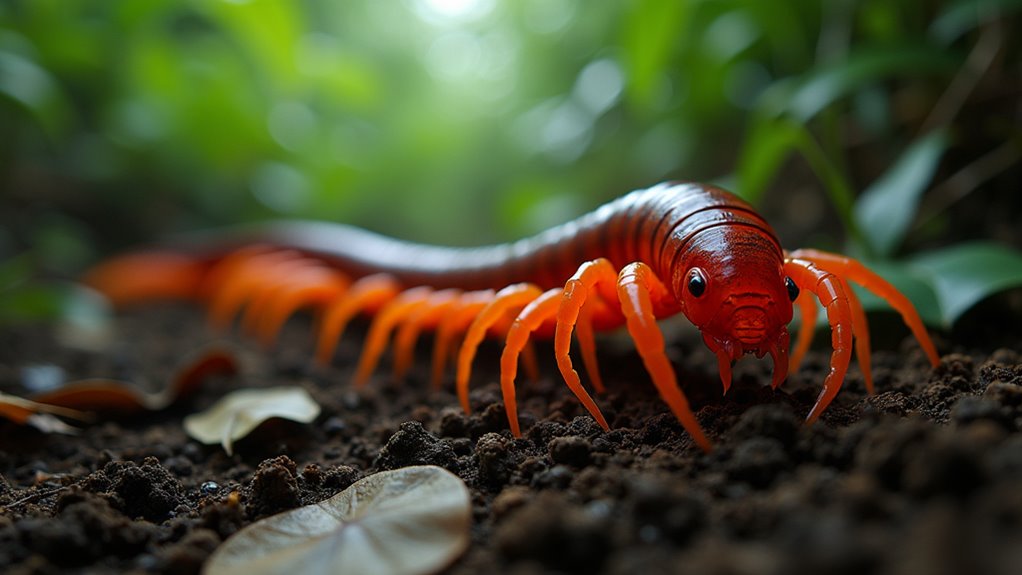
From saltwater predators to terrestrial threats, Thailand’s tropical forests harbor their own formidable hunters. The giant centipede (Scolopendra subspinipes) is among the most feared invertebrates you’ll encounter, reaching lengths of 20cm with venom-injecting forcipules that deliver excruciating stings.
You’ll find these aggressive arthropods in humid, sheltered areas including caves, forest floors, and occasionally inside homes. They’re nocturnal predators that won’t hesitate to pursue perceived threats, delivering multiple painful stings. These centipedes often prey on arachnids and can overpower animals larger than themselves. Beachgoers should be especially cautious as centipedes can hide in coastal vegetation near popular surfing destinations.
While rarely fatal to humans, their venom causes intense burning pain, swelling, and occasionally systemic reactions requiring medical attention. If stung, clean the wound immediately and seek treatment.
Though seldom deadly, giant centipede stings produce excruciating pain and potential systemic effects—clean wounds promptly and get medical help.
Prevent encounters by sealing home entry points, clearing debris from your yard, and avoiding barefoot walks at night when these formidable hunters are most active.
Why does Thailand’s deadliest snake often go unnoticed until it’s too late? The Malayan pit viper’s exceptional camouflage and motionless hunting style make it nearly invisible among forest debris and agricultural areas. You’ll encounter this hemotoxic predator most frequently at dusk or after rain, when it emerges to hunt.
Its unpredictable temperament means it can remain perfectly still when discovered or suddenly strike with lightning speed. During your island getaway to places like Koh Phangan, remain vigilant when exploring forested areas. Always wear protective footwear when walking in forested areas, and avoid leaf piles where these nocturnal hunters rest during daylight hours.
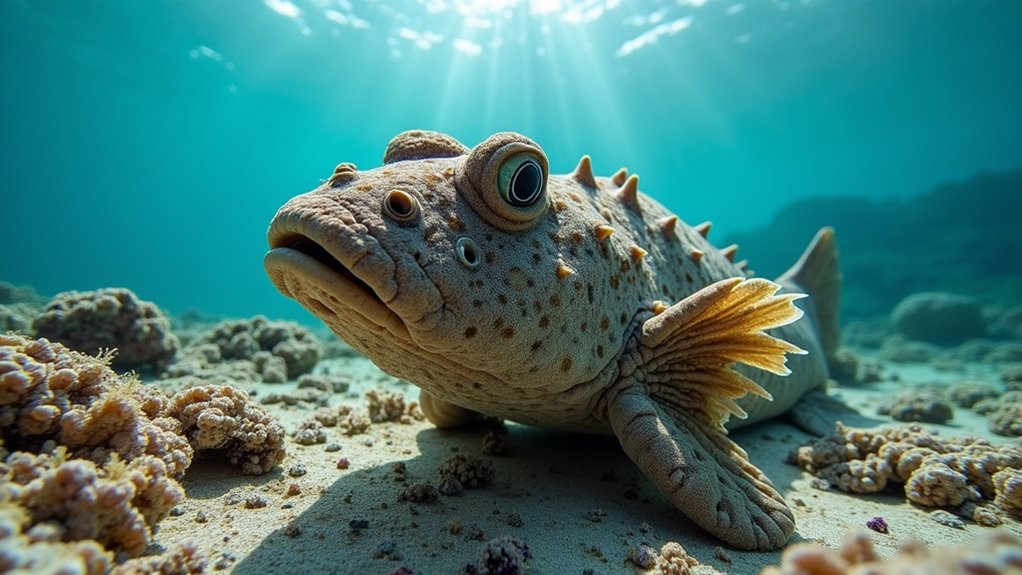
Hidden beneath Thailand’s coastal waters lurks one of the ocean’s most perfectly camouflaged predators—the stonefish. These masters of disguise inhabit shallow tropical waters around popular destinations like Ko Tao and Sairee Beach.
You’ll never see them coming—stonefish blend perfectly with rocky or sandy substrates at depths of 1-20 meters. With their tough, wart-covered skin lacking scales and brownish-gray coloration with patches of yellow, orange, or red, they are virtually indistinguishable from surrounding reef formations. When accidentally stepped on, their venomous dorsal spines inject toxins that cause excruciating pain, swelling, and potentially life-threatening reactions.
If stung, seek medical attention immediately, as antivenoms exist for severe cases. Prevention is your best defense: always wear protective footwear when walking in shallow waters, scan the seabed carefully, and heed local warning signs.
Though stonefish don’t actively attack humans, their perfect camouflage makes them Thailand’s most dangerous coastal threat.
While you’re exploring Thailand’s paradise, stay aware of these potential threats. Like a hidden gem with sharp edges, Thailand’s wildlife is beautiful but can be dangerous. Don’t let fear stop your adventures—just pack knowledge alongside your sunscreen. Remember, most of these creatures avoid humans when possible. Respect their space, know what to look for, and you’ll enjoy Thailand’s natural wonders safely.